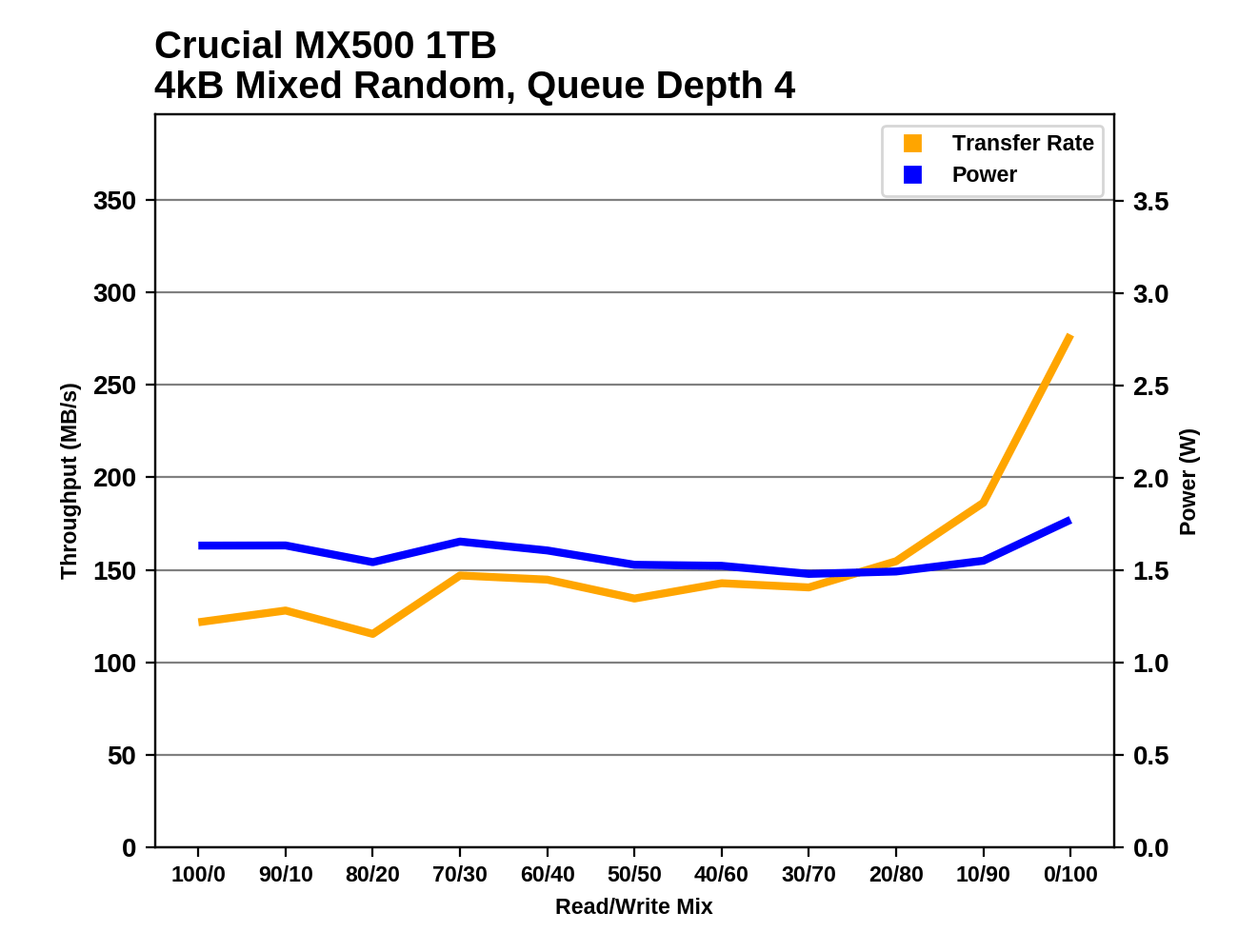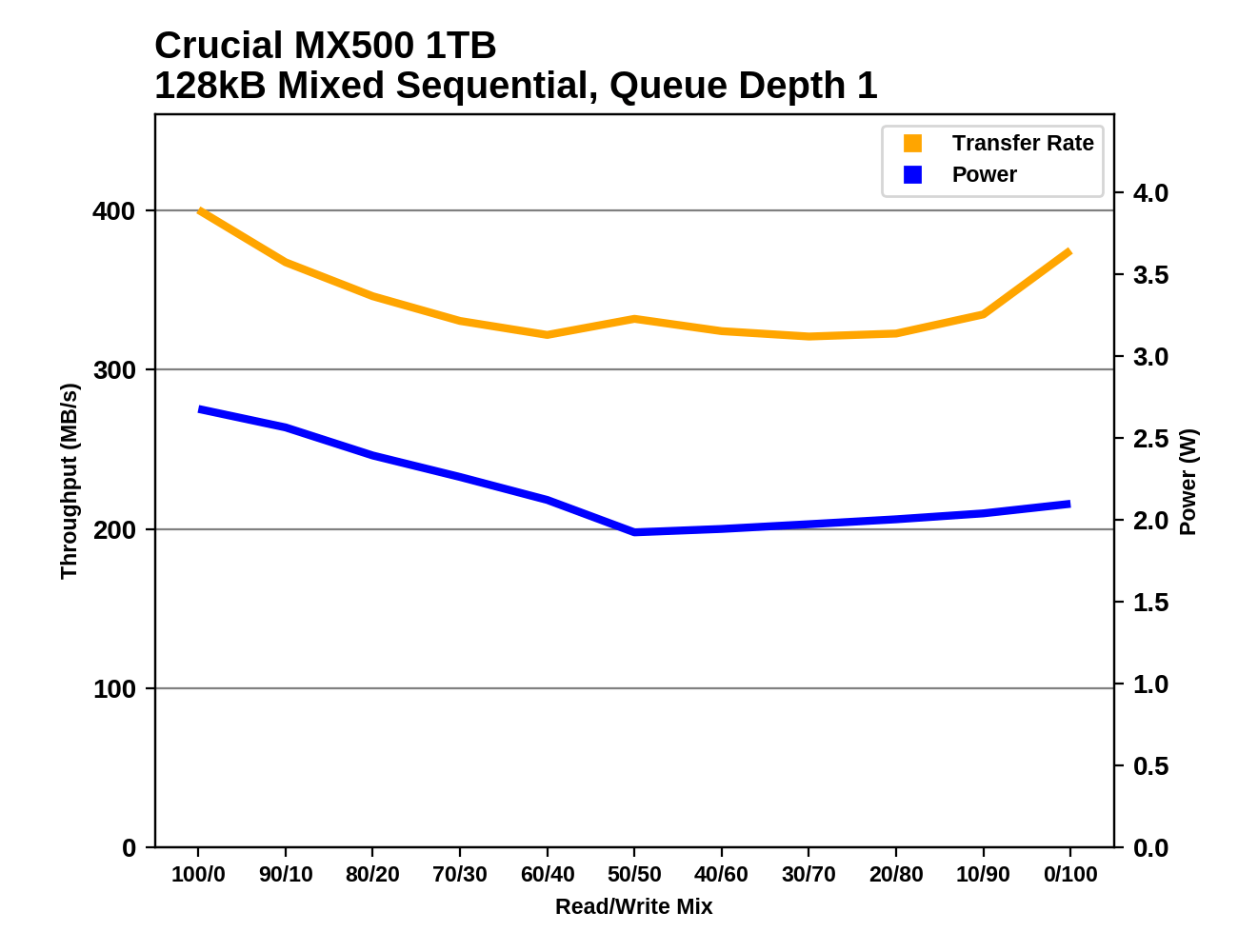The Crucial MX500 1TB SSD Review: Breaking The SATA Mold
by Billy Tallis on December 19, 2017 8:00 AM ESTMixed Random Performance
Our test of mixed random reads and writes covers mixes varying from pure reads to pure writes at 10% increments. Each mix is tested for up to 1 minute or 32GB of data transferred. The test is conducted with a queue depth of 4, and is limited to a 64GB span of the drive. In between each mix, the drive is given idle time of up to one minute so that the overall duty cycle is 50%.

The mixed random I/O performance of the Crucial MX500 is slightly slower than both the MX300 and the Intel 545s, but still above average for mainstream SATA SSDs. The 64L 3D TLC drives from Toshiba and Western Digital/SanDisk are significantly slower, and the Samsung 850 PRO and 850 EVO are still the fastest for this test.

The Crucial MX300 and Intel 545s are tied for first place for power efficiency on this test, with the MX500 coming in third place and well ahead of the other mainstream SATA drives.
 |
|||||||||
The Crucial MX500's performance during this test is a bit unsteady but generally good during the first half when the workload is more read-heavy. The MX500's speed picks up significantly when the workload becomes very write-heavy, but it take too long to start speeding up; other drives like the Samsung 850 PRO and EVO are steadily accelerating with increasing proportion of writes, starting fairly early in the test.
Mixed Sequential Performance
Our test of mixed sequential reads and writes differs from the mixed random I/O test by performing 128kB sequential accesses rather than 4kB accesses at random locations, and the sequential test is conducted at queue depth 1. The range of mixes tested is the same, and the timing and limits on data transfers are also the same as above.

The Samsung 850 PRO and EVO are the fastest SATA drives on the mixed sequential I/O test, and the Crucial MX500 falls into the second tier of drives, along with the other mainstream 64L 3D TLC drives and the MX300.

The Toshiba TR200 and OCZ VX500 score highest on power efficiency for the mixed sequential I/O test because they include little or no DRAM. The MX500 scores reasonably well overall but worse than the MX300 and the Intel 545s.
 |
|||||||||
The Crucial MX500 performs well in the early, read-heavy phases of the test but performance drops toward the middle and only recovers slightly at the end of the test. The minimum performance level across the entire test is quite high, but the fastest drives spend much less time performing at or near their minimum.










90 Comments
View All Comments
mode_13h - Tuesday, December 19, 2017 - link
Actually, you don't need it to upgrade the firmware. But it also does things like over-provisioning and secure-erase. And it can tell you roughly how much write endurance is remaining.ddrіver - Tuesday, December 19, 2017 - link
Overprovisioning, that very advanced function that translates to shrinking a partition and leaving some free space somewhere at the end of the drive using nothing but Windows tools... There is no killer function in these SSD tools. They make FW updates a lot easier for regular people. I don't want to make boot disks and type in my updates. Just click click form the GUI and I'm done. Maybe something like Samsung's RAPID needs the software but other than that you can do it yourself.jabber - Tuesday, December 19, 2017 - link
Yeah I just use Disk Management or Partition Wizard to leave 2-5GB (depending on size) free on all my SSDs.mode_13h - Wednesday, December 20, 2017 - link
Good luck with that. First, it's not much (I usually OP by anywhere from 6.25% to 25% - if you search SSD reviews on this site, you'll see performance benefits even up to 25%).Second, it definitely won't work for all vendors. The SSD firmware needs to know that the unpartitioned space doesn't hold user data, and they don't all derive this information by simply looking for a partition table and parsing that, as you seem to believe.
ddrіver - Thursday, December 21, 2017 - link
Any link for that? The point of overprovisioning is to have space to swap data and do internal reorganization even when the drive is full, for wear leveling. Since most drives support TRIM and you can trigger it manually it's impossible to assume there will be data there. It's like the SSD should stop with the wear leveling because I might have some data in that free space it's using anyway.The ONLY difference between normal free space and OP is that OP will be there even when you regular partition is full. Wear leveling and data reorganization works even with 0 OP when there actually is user data everywhere. It just takes longer.
The second you create an empty chunk of disk space it will be TRIMmed anyway and it becomes really free space. It can even be a partition that you never write to. Windows will TRIM it regardless and the SSD will know the LBAs are empty. No flag needed. But I'd love to see some docs from recent times to say otherwise.
mode_13h - Friday, December 22, 2017 - link
I don't know why you think anyone is TRIMming unpartitioned space, but it's a bad assumption.mode_13h - Wednesday, December 20, 2017 - link
Their documentation seems to suggest it writes something to flag the unpartitioned space as useable for over-provisioning. I don't know how you can easily prove that simply leaving unpartitioned space is equivalent.With certain other vendors, I've seen official statements that simply leaving unpartitioned space is not sufficient for overprovisioning.
Wolfpup - Tuesday, December 19, 2017 - link
Dumb question, but what do you need to use it for? I've never used it, that I can remember, and I've got a couple of Crucial drives. I don't have Java on any of my personal systems either.mikato - Friday, January 19, 2018 - link
Agree. I don’t see how Java is a problem.DanNeely - Tuesday, December 19, 2017 - link
*shrug*While Java apps tend to be clunky to use, for a firmware updater usability isn't a top priority; and Java is an easy way to create an app with the needed low level system access that will run on almost any OS.